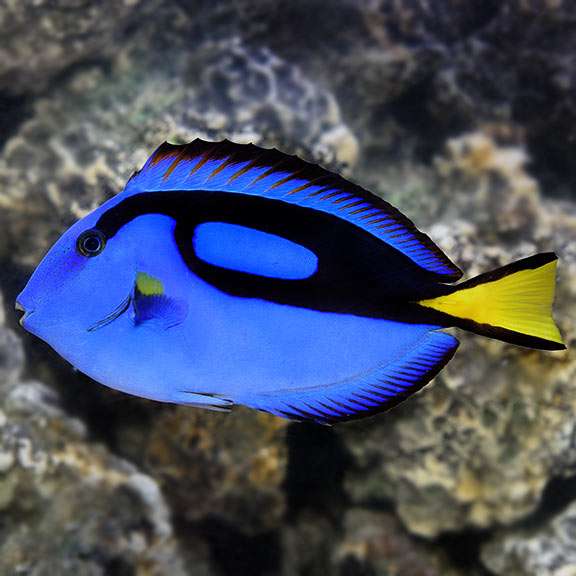
Size
Adults grow up to 12 inches
Physical characteristics and behavior
The regal tang’s oval-shaped bodies are a stunning shade of sky blue. Iridophores, which are exterior fish structures, contribute to the sheen’s shimmering appearance. On the dorsal side of the adult, there may be dark, thin blue lines visible. From the front to the back of the eye, this color is present. This pattern’s tail is a deep, dark blue, while the back is much darker—almost black. Just behind the pectoral fin, a circular region of light blue hue can be seen. The dorsal fin is a bright yellow color, as is the tail fin. Starting at the base of the tail and ending at the base of the spine, the yellow creates a “V” shape.
Care When Keeping as Pet
If given the proper care, blue tangs are not a difficult fish to maintain. Unfortunately, it may get quite expensive to maintain ideal conditions for Blue Tangs. Blue Tangs might be the ideal fish for you if you have previous experience keeping fish in saltwater aquariums.

- Requirements of Tank
It takes a minimum of 100 gallons and a tank that is at least 4 feet long to house a Blue Tang, but your fish will appreciate it if you have the space for a bigger tank. Being an energetic kind of fish, blue tangs thrive when given adequate space to wander. They require a pH of 8.1 to 8.4 and a temperature range of 73F to 81F. The mucosal layer, or slime coat, is significantly thinner on Blue Tangs. They are particularly vulnerable to disease because of their thin slime coat.
In order to prevent your Blue Tangs from getting sick, it is crucial to maintain the proper water quality and cleanliness. Saltwater aquarium maintenance can be time-consuming and expensive.
- Tank Mates
Blue Tangs are thought to be gentle but aggressive. In a single species tank with as much space as you can provide, they do best. They may be quiet, but it does not imply they are not ready to battle. Both sides of the caudal fins of blue tangs are covered in poisonous spines. When the fish feels threatened, these spines stand upright, and when the Blue Tang flails about, it can seriously hurt its prey.
- Feeding
Being herbivorous, Blue Tangs will readily take food in the aquarium whether they are captive-bred or wild-caught. Blue Tangs like nori, plankton, krill, and fish flakes made from algae. It is significant to note that the majority of the Blue Tang’s diet consists of algae.
- Water Conditions
It must have a pH between 8.1 and 8.4 and regular ocean salinity, and it must be between 72 and 78 degrees Fahrenheit.
Table





